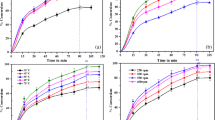Abstract
Waste shortening oil (WSO) from instant noodle factories was used for biodiesel production by transesterification using alkali as a catalyst in a laboratory scale. The effects of various parameters such as potassium hydroxide concentration, methanol/WSO molar ratio, temperature and reaction time on the biodiesel production were investigated. To determine the optimal operating condition for biodiesel production, potassium hydroxide concentration from 0.25 to 1.5 wt%, methanol/WSO molar ratio from 3:1 to 9:1, temperature from 35 to 65 °C and reaction time from 30 to 90 min were employed. The highest ester yield of biodiesel was obtained at the catalyst concentration of 1.0 wt% KOH, methanol/WSO molar ratio of 8:1, temperature of 55 °C, and reaction time of 60 min. Biodiesel obtained had many advantages such as high cetane number, low acid value and carbon residue and can be used as an alternative diesel without modifications to engine or injection system.




Similar content being viewed by others
References
Primata M, Seo Y, Chu Y (2013) Effect of alkali catalyst on biodiesel production in South Korea from mixtures of fresh soybean oil and waste cooking oil. J Mater Cycles Waste Manag 15(2):223–228
Math MC, Kumar SP, Chetty SV (2010) Technologies for biodiesel production from used cooking oil—a review. Energy Sustain Dev 14(4):339–345
Thanh LT et al (2012) Catalytic technologies for biodiesel fuel production and utilization of glycerol: a review. Catalysts 2(1):191–222
Charpe TW, Rathod VK (2011) Biodiesel production using waste frying oil. Waste Manag 31(1):85–90
Zhang Y et al (2003) Biodiesel production from waste cooking oil: 1. Process design and technological assessment. Bioresour Technol 89(1):1–16
Utlu Z, Koçak MS (2008) The effect of biodiesel fuel obtained from waste frying oil on direct injection diesel engine performance and exhaust emissions. Renew Energy 33(8):1936–1941
Araujo VKWS, Hamacher S, Scavarda LF (2010) Economic assessment of biodiesel production from waste frying oils. Bioresour Technol 101(12):4415–4422
Sadano Y et al (2010) Optimization of compost fermentation of glycerol by-product discharged from biodiesel fuel production process. J Mater Cycles Waste Manag 12(4):308–313
Meher LC, Vidya Sagar D, Naik SN (2006) Technical aspects of biodiesel production by transesterification—a review. Renew Sustain Energy Rev 10(3):248–268
Thanh LT et al (2013) A new co-solvent method for the green production of biodiesel fuel—optimization and practical application. Fuel 103:742–748
Bezergianni S, Kalogianni A (2009) Hydrocracking of used cooking oil for biofuels production. Bioresour Technol 100(17):3927–3932
Maeda Y et al (2011) New technology for the production of biodiesel fuel. Green Chem 13(5):1124–1128
Park Y-M et al (2008) The heterogeneous catalyst system for the continuous conversion of free fatty acids in used vegetable oils for the production of biodiesel. Catal Today 131(1–4):238–243
Fajriutami T, Seo Y, Chu Y (2013) Optimization of two-step catalyzed biodiesel production from soybean waste cooking oil. J Mater Cycles Waste Manag 15(2):179–186
Ramos MJ et al (2009) Influence of fatty acid composition of raw materials on biodiesel properties. Bioresour Technol 100(1):261–268
Predojević ZJ (2008) The production of biodiesel from waste frying oils: a comparison of different purification steps. Fuel 87(17–18):3522–3528
Enweremadu CC, Mbarawa MM (2009) Technical aspects of production and analysis of biodiesel from used cooking oil—a review. Renew Sustain Energy Rev 13(9):2205–2224
Tomasevic AV, Siler-Marinkovic SS (2003) Methanolysis of used frying oil. Fuel Process Technol 81(1):1–6
Phan AN, Phan TM (2008) Biodiesel production from waste cooking oils. Fuel 87(17–18):3490–3496
Encinar JM, González JF, Rodríguez-Reinares A (2005) Biodiesel from used frying oil. Variables affecting the yields and characteristics of the biodiesel. Ind Eng Chem Res 44(15):5491–5499
Felizardo P et al (2006) Production of biodiesel from waste frying oils. Waste Manag 26(5):487–494
Freedman B, Pryde EH, Mounts TL (1984) Variables affecting the yields of fatty esters from transesterified vegetable oils. J Am Oil Chem Soc 61(10):1638–1643
Demirbas A (2009) Biodiesel from waste cooking oil via base-catalytic and supercritical methanol transesterification. Energy Convers Manag 50(4):923–927
Freedman B, Butterfield R, Pryde E (1986) Transesterification kinetics of soybean oil 1. J Am Oil Chem Soc 63(10):1375–1380
Leung DYC, Guo Y (2006) Transesterification of neat and used frying oil: optimization for biodiesel production. Fuel Process Technol 87(10):883–890
Eevera T, Rajendran K, Saradha S (2009) Biodiesel production process optimization and characterization to assess the suitability of the product for varied environmental conditions. Renew Energy 34(3):762–765
Ryan TW III, Dodge LG, Callahan TJ (1984) The effects of vegetable oil properties on injection and combustion in two different diesel engines. J Am Oil Chem Soc 61(10):1610–1619
Enweremadu CC, Rutto HL (2010) Combustion, emission and engine performance characteristics of used cooking oil biodiesel—a review. Renew Sustain Energy Rev 14(9):2863–2873
Georgogianni KG et al (2007) Biodiesel production: reaction and process parameters of alkali-catalyzed transesterification of waste frying oils. Energy Fuels 21(5):3023–3027
Knothe G, Bagby M, Ryan T III (1998) Precombustion of fatty acids and esters of biodiesel. A possible explanation for differing cetane numbers. J Am Oil Chem Soc 75(8):1007–1013
Nas B, Berktay A (2007) Energy potential of biodiesel generated from waste cooking oil: an environmental approach. Energy Sources Part B 2(1):63–71
Fernando S et al (2007) Effect of incompletely converted soybean oil on biodiesel quality. Energy 32(5):844–851
Çetinkaya M, Karaosmanoğlu F (2004) Optimization of base-catalyzed transesterification reaction of used cooking oil. Energy Fuels 18(6):1888–1895
Dunn RO, Shockley MW, Bagby MO (1996) Improving the low-temperature properties of alternative diesel fuels: vegetable oil-derived methyl esters. J Am Oil Chem Soc 73(12):1719–1728
Moser BR (2008) Influence of blending canola, palm, soybean, and sunflower oil methyl esters on fuel properties of biodiesel. Energy Fuels 22(6):4301–4306
Author information
Authors and Affiliations
Corresponding author
Rights and permissions
About this article
Cite this article
Hoang, N.S.H., Vinh, L.X. & Hien, T.T. Biodiesel production from waste shortening oil from instant noodle factories. J Mater Cycles Waste Manag 18, 93–101 (2016). https://doi.org/10.1007/s10163-014-0315-1
Received:
Accepted:
Published:
Issue Date:
DOI: https://doi.org/10.1007/s10163-014-0315-1




